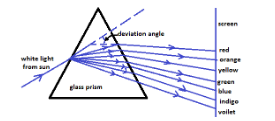Question
Question: In a glass prism, spectrum is produced due to: A. Refraction B. Dispersion C. Scattering D....
In a glass prism, spectrum is produced due to:
A. Refraction
B. Dispersion
C. Scattering
D. diffraction
Solution
A glass prism is made up of the glass which is having a variable refractive index for the different colours of the light having different wavelengths. So due to this reason the light rays got refracted at the different angles and split into the seven different colours.
Complete answer:
The phenomenon of Splitting of the light when it passes through the glass prism into the constituent spectrum of the colours (that are violet, indigo, blue, green, yellow, orange and red.) is known as dispersion of the light.

So, when the light passes through the prism then the refractive index for each colour of the light will be different and hence the angle at which the light will get refracted will be different for the different colours so the light will split into its seven constituent colours. So, in a glass prism, spectrum is produced due to the phenomenon of the dispersion.
So, the correct answer is “Option B”.
Note:
This dispersion phenomenon takes place in the glass prism but not in the glass slab, the reason behind this is that the geometry of the two pieces of the glass.
So, the difference in a prism and glass slab is that emerging colours from the second interface are not parallel to each other in the prism; instead they are diverging, so after a certain distance we see the spectrum with separated bands of colours. While in the glass slab emerging colours from the second interface are parallel to each other that’s why the spectrum of the colours does not happen.
